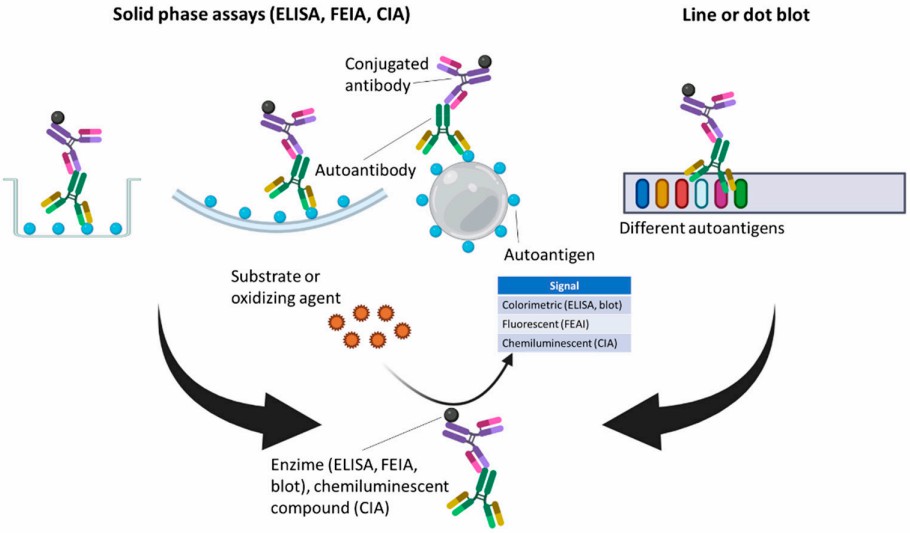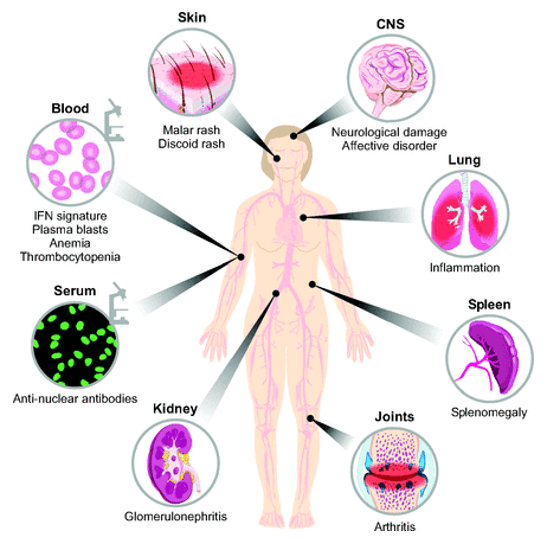NAA Services for Anti-Nuclear Antibody (ANA)
With years of experience and high-end technologies in NAA (natural autoantibodies) research, Creative Biolabs has successfully developed a series of innovative and diversified NAA platforms to provide fast and convenient services for our worldwide customers. At present, we are able to provide a full range of anti-nuclear antibody (ANA) marker services for diseases diagnosis and therapeutic monitoring. Our professional team is optimized to help you get a milestone development in your NAA project.
Background of Anti-Nuclear Antibody (ANA)
Anti-nuclear antibody (ANA), also known as antinuclear factor or ANF, is a type of autoantibody that attacks the proteins within the nucleus of a cell. In healthy individuals, ANA may react with components of the body's own cells and causes signs and symptoms such as tissue and organ inflammation, joint and muscle pain, and fatigue. Most of us have autoantibodies, but typically in small amounts. Because of the high correlation, ANA test has become one of the primary tests for helping to diagnose a suspected autoimmune disorder and other conditions with similar signs and symptoms. Although there are many tests for the detection of ANAs, the most common tests used for screening are indirect immunofluorescence and Enzyme-Linked Immunosorbent Assay (ELISA).
 Fig.1 Screening and confirmation methods for autoantibody detection.1
Fig.1 Screening and confirmation methods for autoantibody detection.1
The Role of ANA in NAA Associated Systemic Lupus Erythematosus
Systemic lupus erythematosus (SLE) is an autoimmune multisystem disease which is characterized by multiple autoantibodies and complement activation. Recent studies have suggested that ANA positivity may disappear over time in some SLE patients. Now, ANA has become an ideal biomarker and immunological hallmark of SLE with superior diagnostic accuracy, and it is widely used in the early and rapid diagnosis based on its reportedly high sensitivity.
 Fig.2 Multi-organ involvement in systemic lupus erythematosus. (Crampton, 2014)
Fig.2 Multi-organ involvement in systemic lupus erythematosus. (Crampton, 2014)
The Role of ANA in Rheumatic Diseases
Rheumatic diseases are characterized by inflammation that affects the connecting or supporting structures of the body - most commonly the joints, but also sometimes the tendons, ligaments, bones, and muscles. ANA test is ordered commonly as a screening test for rheumatic diseases. ANA positivity is highly sensitive to certain rheumatic diseases. The detection of autoantibodies against a variety of antigenic targets plays an important role in the diagnosis of autoimmune rheumatic disease. Screening for ANA is an important initial stage in the assessment of autoimmune rheumatic disease. A high-titer of ANA (>1:160) is more likely to be clinically significant in the presence of autoimmune rheumatic disease.
The Role of ANA in NAA Associated Malaria
Malaria is a mosquito-borne infectious disease caused by parasitic single-celled microorganisms. It has been reported that acute malaria in Ghanaians is associated with an incidence of 25% of antinuclear antibodies, indicating that malaria is associated with the development of antinuclear antibodies. And data show that patients with tuberculosis and malaria present twice frequency of anti-nuclear antibodies than the normal. It is suggested that ANA autoantibody test is essential for the people from or living in the tropics where the incidence of malaria is relatively high, as well as in patients with tropical infections.
The Role of ANA in NAA Associated AIDS
The association between AIDS and autoimmunity has attracted lots of attention from clinical and pathophysiological perspectives. One of the hallmarks of autoimmunity is the presence of high levels of circulating autoantibodies. It is documented that HIV-infected patients present higher overall frequency of autoantibodies (including ANA), which is associated with lower CD4+ cell counts and with higher mortality within 2 years. So, the frequency and specificity of autoantibodies (including ANA) in HIV-infected subjects can be regarded as a biomarker and an immunological hallmark of AIDS.
The Role of ANA in Alzheimer's Disease
Some evidence suggests that immune mechanisms may play an etiologic role in Alzheimer’s disease (AD). It is reported that the elevated number of autoantibodies (including ANA) is associated with Alzheimer's disease along with cerebrovascular disease and vascular dementia. Higher ANA is seen in participants with AD.
What We Can Do about NAA?
Aided by our well-established platforms and experienced scientists, we can provide comprehensive NAA services, from NAA detection, NAA profiling, to NAA epitope mapping. A wide spectrum of NAA products is available for your choice.
Features of Our Services
- Seasoned technology
- One-stop pipeline
- High efficiency
- Best after-sale service
Creative Biolabs is capable to provide the largest and diversiform portfolio of NAA products and services about NAA. Our proven and optimized platforms can help you quickly get satisfactory results without repeated trials. We also provide custom services based on the requirements of our clients to meet the specific demand. Please contact us for more information.
References:
- Irure-Ventura, Juan, and Marcos López-Hoyos. "The past, present, and future in antinuclear antibodies (ANA)." Diagnostics 12.3 (2022): 647.
- Crampton, Steve P., Peter A. Morawski, and Silvia Bolland. "Linking susceptibility genes and pathogenesis mechanisms using mouse models of systemic lupus erythematosus." Disease models & mechanisms 7.9 (2014): 1033-1046.
Related Services:
- NAA Services for Anti-Double-Stranded DNA (dsDNA)
- NAA Services for Anti-Smith
- NAA Services for Anti-Ribonucleoprotein (RNP)
- NAA Services for Anti-Ro Autoantibodies
- NAA Services for Anti-La Autoantibodies
- NAA Services for Rheumatoid Factor (RF)
- NAA Services for Anti-C3
- NAA Services for Anti-C4
- NAA Services for Anti-C1q

